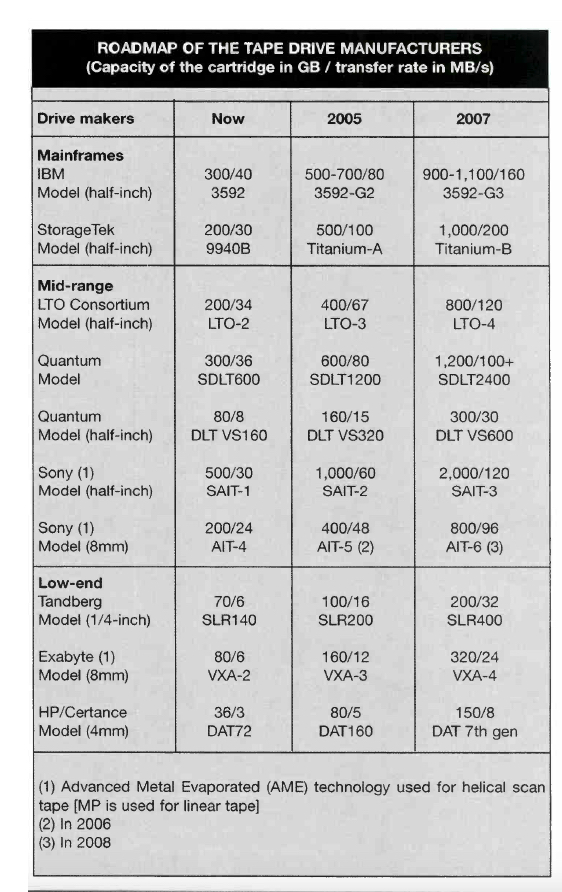History 2004: Imation Tries Terabyte Technology to Take on Japanese
With Tera Angstrom
By Jean Jacques Maleval | April 24, 2024 at 3:00 pmThe computer tape media industry can be analyzed quite simply: on the one hand, there is the U.S. firm Imation, on the other are the 5 Japanese players: Fuji, Maxell, Sony, TDK and Mitsubishi/ Verbatim. The last European in the game, Emtec, saw what remained of its manufacturing facilities fall under Imation’s control.
The latter has fumbled rather painfully over the past few years, ignoring some important media storage technology developments such as optical discs, helical scan and DLT tapes. It came back to DLT after a messy fight with Quantum, and hopped onto the LTO bandwagon.
The company does in fact manufacture some CD-RW discs, but essentially obtains these from Asian manufacturers, particularly the Indian firm Moser-Baer, via a joint venture between the 2 companies, Global Data Media.
Imation’s sales breakdown into 55% to 60% from professional media, 40% to 45% in consumer media, primarily optical discs.
The U.S. firm is proud still to be manufacturing floppy disks, a market that is still significant, but diving.
Its strongest points until now have been the QIC/Travan and Tandberg SLR cartridges in which it has a monopoly, but they remain a niche market. And then there are the mainframe class cartridges, the juiciest market of all.
In tape media applications, Imation hopes to maintain 85% of the market for enterprise-class computers, 20% in mid-range network computing and 15% in entry-level servers. It thus has a near monopoly for what are essentially the most expensive media, supplying users of IBM’s and StorageTek’s mainframe drives.
More recently, however, Fuji has emerged (with its Nanocubic technology*) in an attempt to seduce 2 drive manufacturers that will be delighted to welcome a 2nd source for the media.
More threatening for Imation, however, is the fact that it was losing its technological lead, having fallen behind with MP (Metal Particulate) technology – with higher coercivity than chromium dioxide – already in its MP3 (or MP+++) version, with the forthcoming MP4/5, still known as MPX, reserved essentially for the next gen of very high-capacity cartridges.
Imation has (finally) reacted seriously. It has just perfected what it calls Tera Angstrom technology in its Oakdale, MN HQ, a proprietary MP advanced formulation and process that should keep it at the grown-ups’ table.
The company has also decided to invest $50 million in a state-of-the-art manufacturing facility at its Weatherford, OK plant to begin to produce these new high-density tapes in capacities upward of 200GB.
The capacity of a tape depends on 3 parameters: the length of the tape (the thinner it is, the more can be housed in the cartridge), the number of tracks per inch (tpi), and lastly the number of bits per inch (bpi) along each track, with the latter 2 parameters determining the areal density, measured in megabits per square inch (Mb/in2).
If we take the SDLT600 cartridge, with native capacity of 300GB, currently the highest capacity available at the mid-range, those figures are 596m, 1,490tpi, 233Kbpi, for 347Mb/in2. IBM’s 3592 of the same capacity has close numbers: 580m, 1,233tpi and 277Kbpi, for 342Mb/in2.
Note, however, that the areal density of HDDs today is of a much greater order, nearly 100Gb/in2.
To get better results on tape, the company has reduced the pigment size with substrate and coating smoothness improvement to increase the bit density, and has also tried to reduce the substrate and coating thickness in order to obtain thinner, and consequently longer tapes.
To keep it simple, Imation has perfected a proprietary technology based on 3 processes for its Tera Angstrom project:
1) impingement to reach nanometer-sized magnetic particles [high-pressure jets to create particles],
2) quiescent drying to achieve a high degree of particle orientation,
3) in-line “calendaring” for smoothness with rollers to compress the tape surface.
Thanks to all these development, Imation, along with its competition, have outlined their respective roadmaps, as seen in the table at right.
* The magnetic layer in Nanocubic tapes consists of fine acicular MP or barium ferrite platelets.

This article is an abstract of news published on issue 198 on July 2004 from the former paper version of Computer Data Storage Newsletter.















 Subscribe to our free daily newsletter
Subscribe to our free daily newsletter

